Another day full of energy! Breakfast in Lisbon is always a treat – fresh orange juice, omelettes stuffed with crispy bacon, the famous pastéis de nata (Portuguese egg tarts), samosas, and their beloved pastéis de bacalhau, a fried snack made with soft codfish inside. Breakfasts here can be so rich and flavorful that we often find ourselves drooling over them the night before, eager for morning to come so we can dive into the delicious spread and set the day in motion.

Today, we’re off to Pena Castle, a place straight out of a fairytale with its bold colors and imaginative, storybook design. (More on that later!) Getting there from Lisbon’s city center is quite convenient, with several options: train, bus (1.5–2 hours), or car (40–45 minutes). We chose the train – a popular choice for many travelers.
To get your train ticket, simply go to Rossio Station in central Lisbon. The round-trip ticket costs around €4.50, and trains run about every 30 minutes or so (more info incl. timetables). The journey takes around 40 minutes and will take you to Sintra Station, the gateway to Pena Castle.

Once you arrive at Sintra Station, you have a few options to reach the castle. A quick tuk-tuk ride (about €10–15) will get you there in 10 minutes, or you could hop on the local bus (more info). But we highly recommend the hike up to the castle. The trail takes around 45 minutes, offering a moderately easy climb through lush greenery with stunning views over Sintra’s rolling hills.


One tip: If you’re hiking, you may want to stop by the restroom at the train station. It costs about 50 cents to 1 euro, and the next opportunity won’t be until you reach the castle entrance.
After arriving at Sintra Station, we set off on the scenic Vila Sassetti Trail (more info). It’s an easy walk from the station, and soon you’re on a path that feels like a retreat into nature.
The way is absolutely stunning. As we walk, we come across small ponds, their surface dotted with floating lotus leaves, while a gentle waterfall cascades down, its soft murmur blending with the rustle of leaves. Everything we see is framed by brilliant greenery, from ferns to moss-covered stones, all teeming with life.


Here and there, splashes of color punctuate the sea of green – radiant reds stand bright and proud, while tender purples sway pure and soft – nature’s charm was on full display.



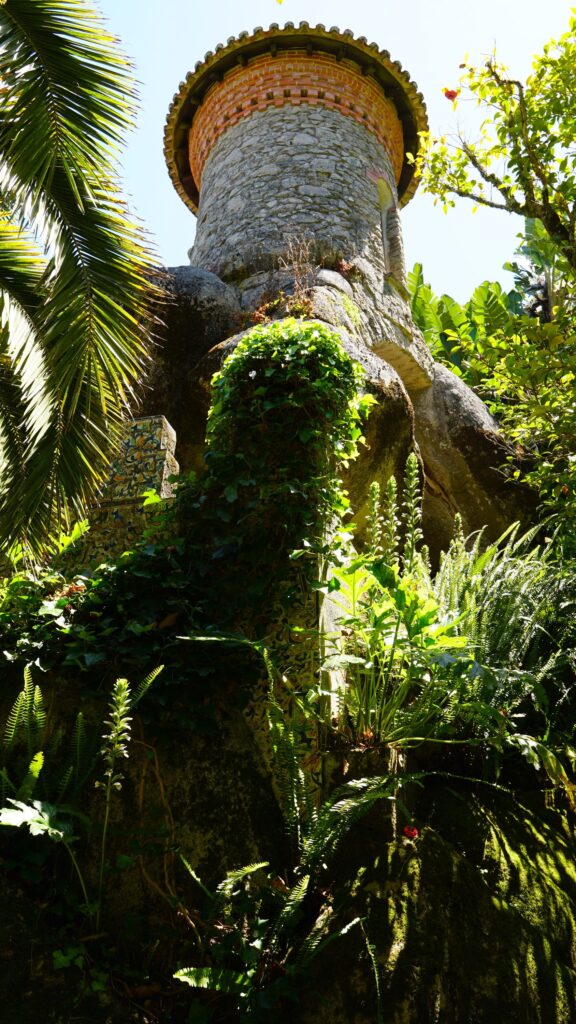
Along the way, we pass a little house nestled in the woods. Its warm, earthy architecture, partly cloaked in creeping vines, seems like a quiet witness to the power of nature, slowly being reclaimed by the forest – an untouched, a relic of the past, hidden from the usual tourist paths.

The path itself is mostly flat and easy to walk, shaded in places by wooden pergolas, entwined with climbing plants that create a natural canopy overhead.
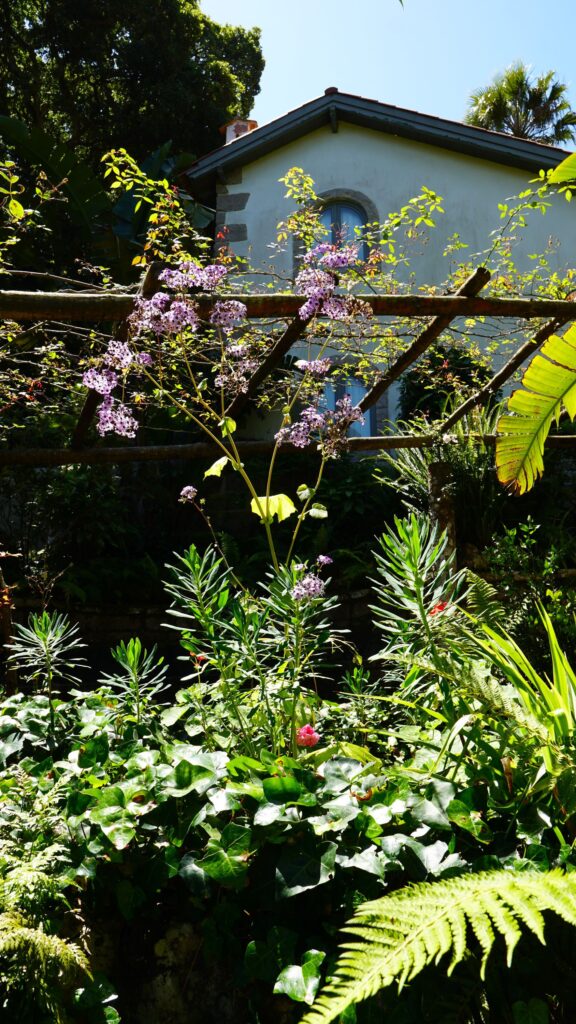
Following the Vila Sassetti Trail, you can visit the Moorish Castle, an ancient ruin built by the Moors in the 8th or 9th century. Blending with the lush landscape, its weathered stone walls and rugged towers are softened by creeping vines and moss, exuding a sense of history and mystery.

This medieval fortress requires a ticket (around 8 EUR for adults) for entry, and once inside, you can climb the castle walls for a spectacular view. From the top, you’ll have a panorama over Sintra, with a clear line of sight to Pena Palace and, on a clear day, even glimpses of the distant Atlantic Ocean!
To walk surrounded by such beauty, it’s easy to get lost in the pulse of nature – in every leaf and in every sound of trickling stream – reminding us of life’s resilience and the silent power of the earth. Before long, step by step, we find ourselves gazing up at the dreamlike Pena Castle, towering right above us.

The Pena Palace is a sight like no other—a fusion of styles, colors, and stories from various historical eras, all woven into a kaleidoscopic masterpiece.

Originally a monastery, the 19th-century site was reimagined as a royal summer residence by King Ferdinand II, whose eclectic tastes and romantic spirit brought this palace to life. With Gothic, Manueline, Renaissance, and Moorish influences, the palace reflects King Ferdinand’s desire to merge styles from across times and places, creating an almost fairytale ambiance.

The vibrant reds, purples, and yellows that splash across the palace walls echo the romanticism of the era, with each color rich in symbolism – the bold red, for instance, signifies strength and courage, while the bright yellow adds an air of royalty and warmth.


The iconic red clock tower, a Gothic revival addition, punctuates the skyline with a medieval elegance.


Scattered throughout, the delicate Chinese porcelains—some decorated with European religious imagery—reflect the 19th-century fascination with the East and add a touch of mystery.


The bedroom is equally lavish, with a four-poster bed draped in deep red, capturing the Rococo spirit of indulgence and luxury.

One of the most intriguing details is the “Triton Gate,” a doorway watched over by a sculpted figure, half-man, half-monster, surrounded by sea motifs. This creature, believed to represent the mythological Triton, embodies the connection between humanity and nature, a tribute to the palace’s harmonious relationship with its natural surroundings.
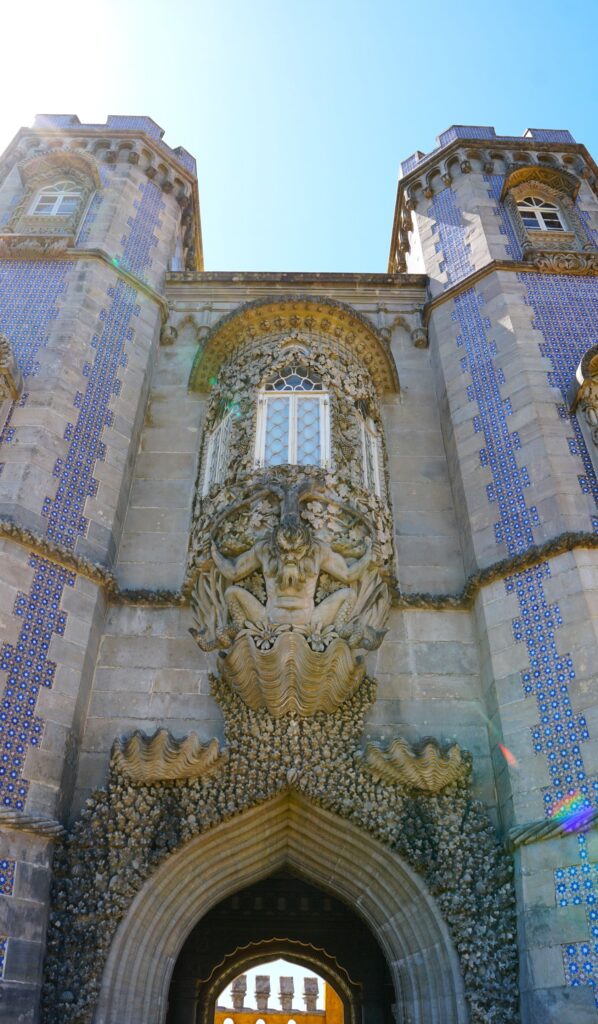

Chandeliers generously grace the palace, casting a soft, romantic glow throughout the spaces.

The living room has an Indian or Moorish feel. The plush red sofas, intricate patterns, and warm colors evoke a sense of opulent Indian decor.

The hunting room is spacious and flooded with natural light, with a simple central pillar that draws the eye upward, giving the room a lofty, open feel. The palette of white and blue adds an airy brightness, contrasting with the more richly adorned rooms elsewhere in the palace.

The small chapel, with its famous stained-glass window, is a highlight of this castle, telling pictorial stories of nobility, faith and history.
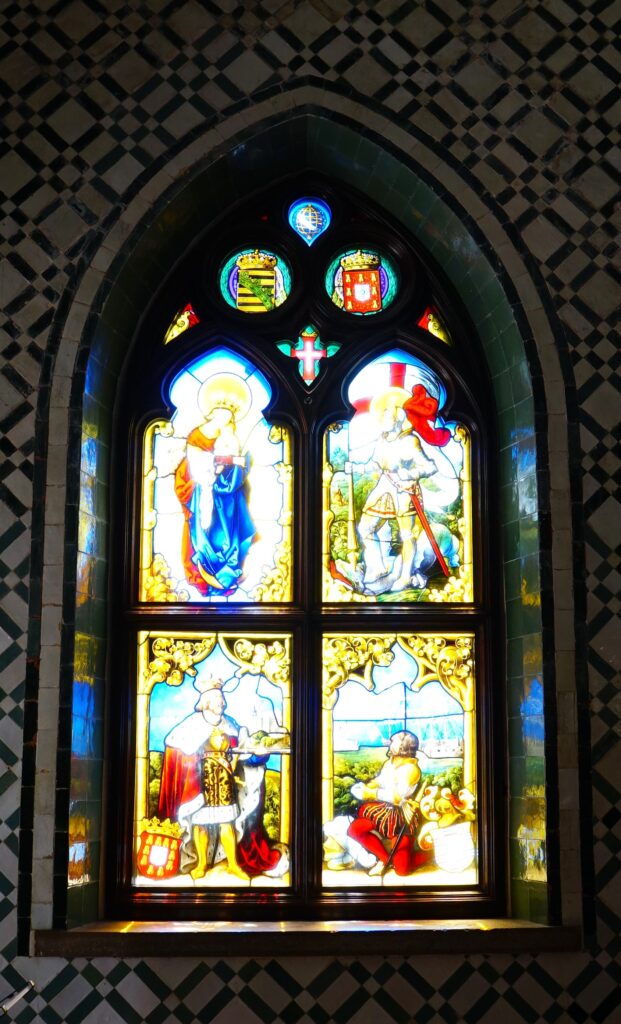
From every angle, the views are breathtaking, with the lush green mountains unfurling in a panorama that feels surreal – like a dreamscape suspended between reality and fantasy. A keen childlike sense of wonder can be felt in many parts of Pena Palace design, as if King Ferdinand intended it to be a timeless testament to creativity, color, and imagination —a world untouched by the passage of time.
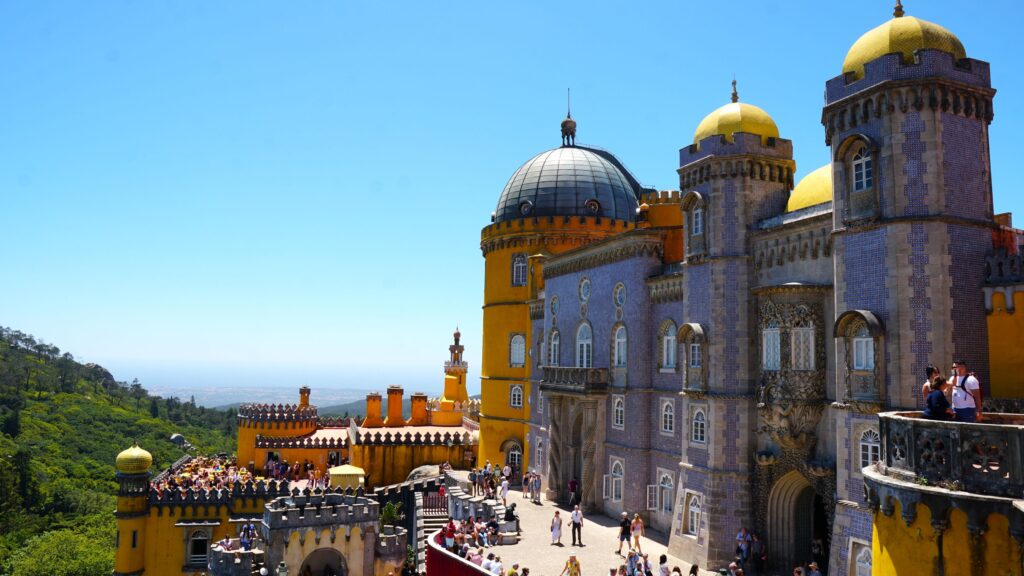

And, just visible in the distance, you can see the nearby Castle of the Moors, a medieval fortress standing among the hills of Sintra.

More tips for your visit:
- Tickets: It’s a good idea to buy your tickets to Pena Castle in advance to avoid long lines. You can buy them online through the official Sintra parks website.
- Arriving in Sintra: Expect to arrive around 8:40 AM, especially if you plan to hike to the palace (about 45 minutes).
- Time at Pena Palace: Plan to spend around 2-3 hours exploring the palace, incl. touring the interior, enjoying the views from the castle, and strolling through the surrounding gardens.
- Aside from Pena Palace: After visiting Pena Palace, consider exploring other nearby attractions like the Moorish Castle or Quinta da Regaleira. You can easily spend another 2-3 hours in Sintra, enjoying the town and its historic sites. If you take the Vila Sassetti Trail, you can consider visit Moorish Castle before heading to Pena Palace. This scenic 2.6 km (1.6 miles) hike takes about 45 – 60 minutes.
- Total Time in Sintra: About 6-8 hours. Plan for a full day, departing Lisbon in the morning and returning in the late afternoon or evening.
- Train Back: Plan to catch a train back to Lisbon around 5:00 PM or 6:00 PM. Trains run regularly (timetables), the last train back to Lisbon leaves around midnight, giving you ample time to explore.

After exploring Sintra, we found ourselves just in time for dinner. Wandering through a lively market, we followed a quaint little path that led us to a place hidden deep in the alley—a restaurant that happened to serve exactly the dishes we were craving that evening. So, our recommendation goes to Cantinho da Vila, a standout among Sintra’s many great dining spots. This cozy eatery specializes in grilled dishes, with various meats and seafood options. Highlights include local favorites like smoky chorizo, cod fish, charred octopus, and asparagus—a delightful surprise!

We started off with Guilho Prawns, a Portuguese classic. These plump, juicy prawns are seasoned with slightly smoky red peppers, a touch of cilantro, and a sprinkle of bay leaves – a favorite in Portuguese cooking – adding an aromatic note.

Dressed in a warm, slightly spicy red sauce, each bite bursts with rich, savory flavor, with a hint of the sea that makes the prawns taste wonderfully sweet, briny, and fresh!
Next up, we tried Polvo à Lagareiro—a grilled, plump, juicy octopus atop golden-baked potatoes and sprouts. The whole octopus, shiny from its rich olive oil dressing, has an irresistible, slightly charred look, especially around the natural “suction cups” on its tentacles. These tiny charred spots add a light, smoky crunch to each bite, enhancing the contrast between the crispy tips and the fat, tender flesh of the octopus.

The flavor is intense and fresh, with an oceanic depth that lingers. Octopus this soft and succulent is a rare find – this dish really brings out the heart of Portuguese seaside flavors.
Our final dish, Bacalhau no Brasa —grilled cod fish paired with beautifully charred green asparagus – graces many tables in this restaurant. The cod, with its crisped edges and a light char, has just a good amount of saltiness, brightened by a sprinkle of microgreens for a fresh touch.

The meat is tender and flaky, with that signature flavor of savory and subtly briny, carrying a hint of smokiness. The green asparagus adds a touch of earthy sweetness, balancing the cod’s rich, oceanic taste. This dish is simple, yet a good start for anyone looking for Portugal’s authentic local flavors.
As we wrap up our journey through the fairy-tale wonders of Pena Palace, we hope you’ve enjoyed the read – about the magic and kaleidoscopic imaginations woven into its walls and timeless design. Next time, we’ll stay in Lisbon but go out of the city center to check out the Parque das Nações, where contemporary marvels and stunning vistas await. Until then, keep dreaming and stay intrigued!




